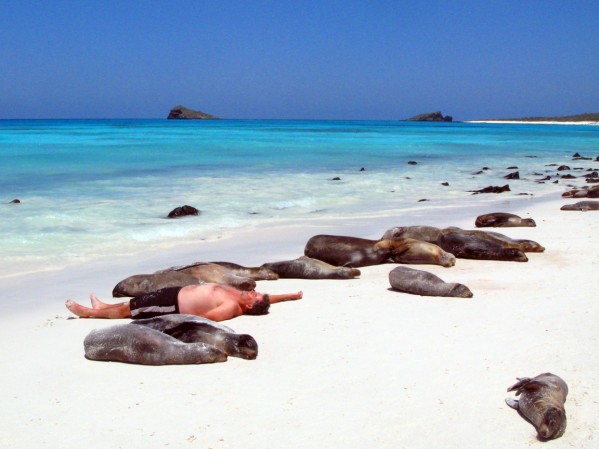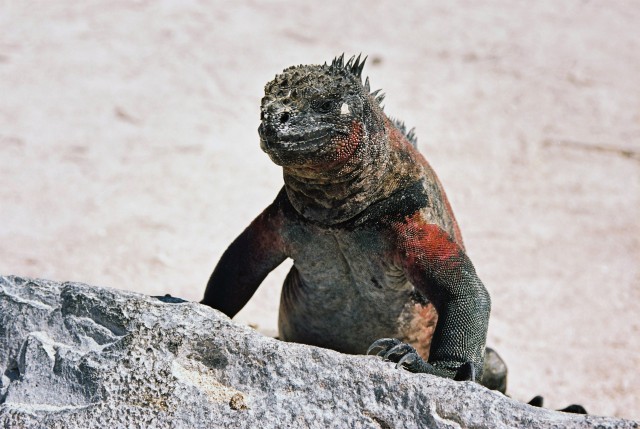Last week we went through how we’ve designed both of our itineraries, A and B, to ensure you get to see and experience as much as possible while in the Galapagos. Most of picking your perfect Galapagos itinerary starts with deciding what is most important for you to see and do, especially when it comes to the wildlife in the Galapagos. Wildlife is everywhere you look in the Galapagos, so we guarantee you won’t leave without seeing a large variety of animals, but if there is a specific species of bird or wildlife that you want to see more of than your itinerary does matter.
Here is our Top 10 Must See Wildlife for your next Galapagos Itinerary:

Giant Tortoises
Known for:
The Iconic Lonesome George is no longer with us but that doesn’t make these large tortoises any less popular. They are mainly known for their large size and dinosaur like appearance. They can grow to be over 500 lbs and as long as 4 feet+, with a lifespan of over 100 years.
Where you can find them:
The Galapagos Tortoise was native to each of the big islands, in addition to the five major volcanoes on Islabela Island, but have now become extinct on Fernandina, Floreana, Pinta and Santa Fe (due to both natural causes and exploitation).
You can see tortoises in their natural habitat at Reserves like El Chato Tortoise Reserve on Santa Cruz where rangers preserve the area to protect the tortoise population, and at private farms such as Las Primicias. We find them at Urbina Bay, Isabela (itinerary B) roaming around.
You can also visit the Charles Darwin Research Station and learn about the conservation efforts of the tortoises. You will see the baby tortoises start small, and learn about the incubation, hatching and growth stages of the tortoises.

Land Iguanas
Known for:
Land Iguanas are endemic to the Galapagos Islands and can reach lengths of 3 – 5 feet. They share a symbiotic relationship with birds, the birds remove parasites and ticks providing relief to the iguanas and food for the birds.
Where they can be found:
Native to 6 islands, these iguanas are usually seen basking on volcanic rock absorbing the heat from the sun. We find them on South Plaza (itinerary A) and Cerro Dragon (itinerary B).
Marine Iguanas
Known for:
Marine Iguanas are the only sea-going lizard in the world. It lives on land, but feeds on seaweed along the rocks.
Where you can find them:
You can find these unique iguanas on almost every rocky shoreline in the Galapagos Islands. We see the largest colonies on North Seymour (itinerary A) and Punta Espinosa, Fernandina (itinerary B).

Sea Lions
Known for:
Galapagos sea lions are plentiful in the archipelago and are most guests first animals they encounter. Their playful and curious nature makes them one of visitors favorite.
Where you can find them:
You can find these sea lions lounging on benches in town, sleeping on boats and playfully swimming in the water. You will see colonies in groups along the beaches, mostly found on our itinerary A. Watch out for the bull male, he can be very protective over his colony.
Frigate birds
Known for:
They are most known for and recognizable by their bright red gular pouch that inflates to show off when a male frigate bird is breeding. Both the Magnificent and the Great Frigate birds are found here.
Where you can find them:
You will find colonies on many of the islands, but North Seymour (Itinerary A)Island has a consistently active, magnificent frigate bird colony. The Great frigates can be found on Darwin Bay, Genovesa (Itinerary B).
Boobies: Blue footed, Red footed and Nazca boobies
Known for:
- Blue footed boobies are known for their bright blue feet and their famous mating dance. They pick up their feet showing off the bright color as they bow with wings spread and beak pointed to the sky. It is quite the sight to see!
- Nazca Boobies are known for their facemask appearance and being the largest of the boobies in the Galapagos.
- Red footed boobies are the smallest and are identified with their bright red feet and blue bill.
Where you can find them:
- Red-footed boobies are found roosting in trees on Punta Pitt (itinerary A) and Prince Philips Steps, Genovesa (itinerary B).
- Large colonies of nesting blue footed boobies are found on North Seymour and Espanola Island (itinerary A). They are also seen on itinerary B on various islands.

Galapagos Penguins
Known for:
The only penguin that lives at, or just above the equator.
Where you can find them:
The penguin population in the Galapagos is concentrated in the colder nutrient-rich waters in the western islands. You will find over 90% of the population on Fernandina and Isabela (itinerary B). There are a few small colonies off the coast of Santiago on Bartolome (itinerary A) and the northern coast of Floreana (itinerary A).

Darwin Finches
Known for:
Charles Darwin’s theory of natural selection was formed after he discovered several species of finches that varied form island to island.
Where you can find them:
There are 13 species of these small birds and are known collectively as Darwin Finches. They are wide-spread through the archipelago except Genovesa and smaller islands of the northwest. Specific species aren’t found on certain islands, so if there is one you want to see, email us to confirm your itinerary will take you to see one of these small finches.

Flightless Cormorants
Known for:
Endemic to the Galapagos, this is the only cormorant that has lost the ability to fly and is largest of its kind. It’s webbed feet and powerful legs propel it through ocean water as it searches for fish, eel and small octopuses to eat.
Where you can find them:
Flightless Cormorants are found on only two islands, Fernandina and Isabela . They spend time on the shallow coastal waters and rocky shores of these volcanic islands. Which means if seeing these unique birds is on our list you will only be able to see these on Itinerary B.
Waived Albatross
Known for:
Albatrosses are known for being the largest of the sea birds with an impressive wing span of 8 – 11 feet.
Where you can find them:
These birds breed primarily found on Espanola Island, while some have been seen breeding on Genovesa Island. We recommend you pick the itinerary A if you want to see these unique birds.








